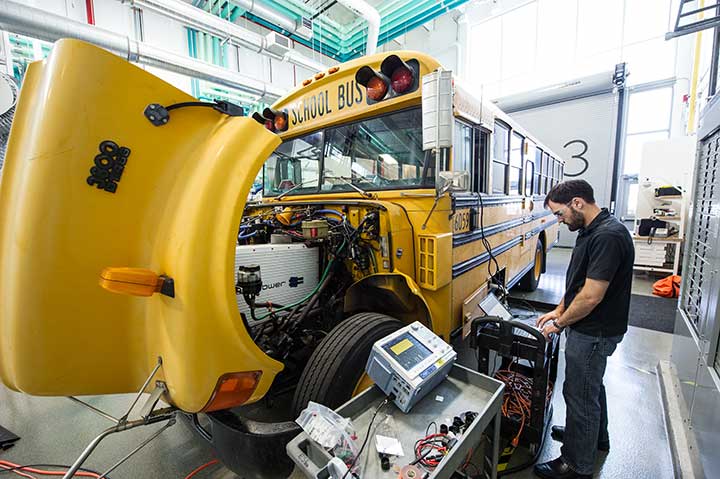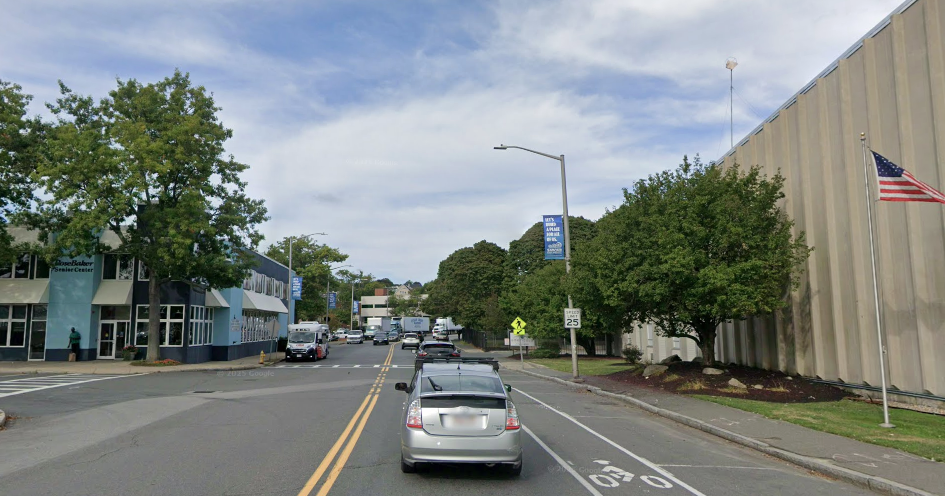On July 14th, Governor Baker signed on to a multi-state pledge that commits the Commonwealth to ramping up the adoption of electric trucks and buses in the next decade – but there’s considerable uncertainty about whether the pledge is ambitious enough to help Massachusetts meet its latest climate goals.
Under the Multi-State Medium- and Heavy-Duty Zero Emission Vehicle Memorandum of Understanding, Massachusetts joins 14 other states and Washington, D.C. in declaring that zero-emission vehicles will make up at least 30 percent of new bus and truck sales by 2030, and 100 percent by 2050.
In 2018, there were over five million vehicles registered in Massachusetts, according to the Federal Highway Administration; of those, 2.2 million were cars, and 2.7 million were medium- to heavy-duty vehicles.
The new memorandum of understanding (MOU) focuses on the latter category, which includes commercial vans, delivery trucks, school buses, and long-haul tractor trailer trucks. These vehicles account for about a quarter of the transportation sector’s climate pollution in the United States as a whole.
The first proposed policy in the MOU is to enact the Advanced Clean Truck Rule, which California officially passed in June. The rule specifies that, by 2030, 30 to 50 percent of the trucks that manufacturers sell must be zero-emission vehicles.
The MOU does not specifically say how and if each state will adopt the Clean Truck Rule, but manufacturers appear to be gearing up to meet the demand: there are already over 25 manufacturers that offer over 70 models of electric trucks and buses in the United States.
Jimmy O’Dea, a senior vehicles analyst at the Union of Concerned Scientists, believes the MOU is a landmark first step to begin taking actions on emissions from heavy duty trucks.
However, O’Dea warns that the vast majority of polluting trucks being sold today will still be on the roads in 2030. Based on typical turnover rates, he estimates that, even if the states meet these new targets for electric truck sales, only 5 percent of trucks on the road would be zero-emission vehicles that year.
“That’s how I characterize these policies,” says O’Dea. “They’re steps, but they’re no means an end goal to reduce emissions.”
Under pending legislation in the Massachusetts legislature, the Commonwealth would need to reduce emissions “at least 50 percent below 1990 levels” by 2030.
The MOU rides on the back of a 2018 multi-state Zero Emission Vehicle Action Plan. Through that program, Massachusetts began offering a $2,500 rebate for electric vehicles to consumers, and planned to increase partnerships to kick-start the electric vehicle market.
To date, that program has subsidized over 16,000 vehicle purchases, and the program estimates that it has saved over 40,000 metric tons of greenhouse pollution over the years.
That’s a drop in the bucket compared to the Commonwealth’s total greenhouse gas emissions, which amounted to 73 million tons in 2017 (the last year for which data is available). Of that total, 30 million tons came from petroleum consumption by cars and trucks.
Partly because electric vehicles have had such a tiny impact to date, the climate plans for the cities of Boston, Somerville, Brookline, and Cambridge are more focused on getting cars off the road – a goal which also reduces traffic congestion and increases safety on city streets.
Boston’s climate plan aspires to reduce the share of citywide trips made by automobile by 50 percent within the next decade, with increased transit use, walking, and biking making up the difference. Unfortunately, there’s also been little progress made toward that goal; last year, the Boston Globe’s Seeing Red investigation reported that there were 300,000 more cars and trucks registered in Boston in 2019 than in 2015.
By focusing on trucks, the new MOU may have a bigger impact on public health. That’s because diesel-burning trucks and buses are also one of the biggest sources of other harmful pollutants, like soot and nitrogen oxide emissions.
The MOU includes a statement recognizing that pollution disproportionately affects lower-income communities and neighborhoods of color, and while it offers no concrete measures to help those communities specifically, an overall reduction in the number of diesel-burning engines on the roads should help.
A 2019 report from the Union of Concerned Scientists found that communities of color in Massachusetts experienced 66 percent more air pollution from vehicles than white residents, largely because those communities are more likely to be near freeways and trucking hubs.
COVID-19 has further illuminated disparities between cities in the Commonwealth, linking neighborhood air pollution to increased death rates from COVID-19. Gateway cities like Chelsea, Brockton and Lawrence have reported the highest infection rates in Massachusetts during the pandemic, and also suffer from higher levels of particulate matter pollution from tailpipes.
Within the next six months, a multi-state task force is expected to develop a plan to implement the MOU. O’Dea says that process will ultimately determine how successful the MOU is.
“If we have vehicles on the road, we want them to be zero emissions,” says O’Dea. “But the communities most affected [by air pollution] should be a guiding principle for these policies.”






